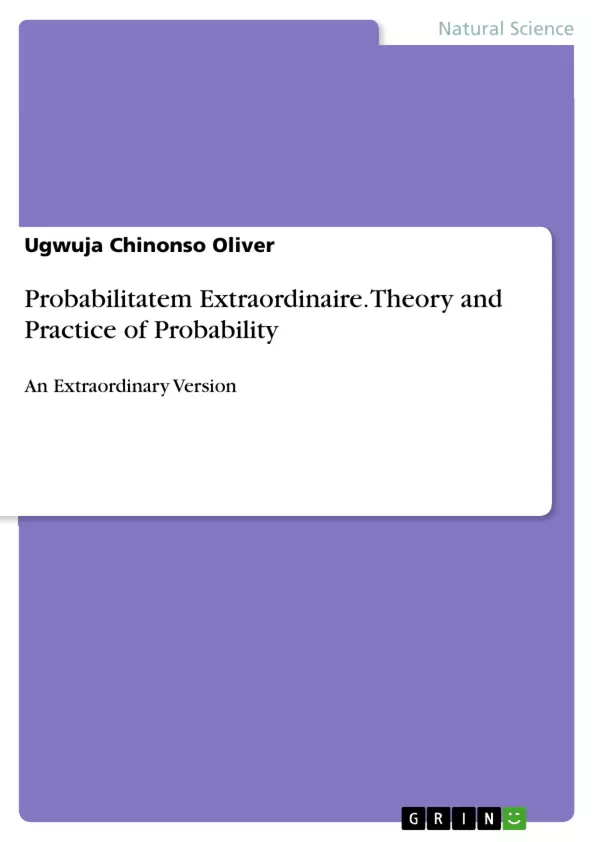Probability is extremely important in today's society, and the theory has several practical applications. For example, scientists utilize the notion of probability to predict the risk of a pandemic emerging in the future, and doctors use probability theory to estimate the likelihood that a patient would react to a specific therapy or die from the sickness. In reality, it is no longer news that many individuals make a lot of money by gambling and betting on games, and probability, which started in gambling, has become a highly valuable instrument that gamblers use to stack the odds in their favor and increase their gambling revenue. It is because probability has become so valuable in our society and is extensively taught in high schools, colleges, and universities, that I choose to focus this book on theory and practice of probability.
Probabilitatem Extraordinaire is a textbook that I wrote based on my 15 years of teaching experience. In my teaching experience, I observed that some students study at a very slow rate, some at a fast pace, and some at an average pace. Furthermore, nearly all students who learn at slow or medium speeds are numerophobic, which means they have a strong phobia or dread of studying mathematics and other calculative courses, and this fear is known as arithmophobia. As a result, Probabilitatem Extraordinaire was composed with the understanding that individuals have varying learning speeds, particularly those who learn slowly.
The text was carefully compiled to ensure that even students with no prior exposure to math-related subjects or those apprehensive about STEM-related subjects can comprehend the entire content of this book should they choose to engage with it. An intriguing aspect of this book is that not only is it presented in a highly simplified manner, but it is also designed to be exceptionally appealing to readers. Consequently, any learner who encounters this book for the first time will be enticed to read it in its entirety.
Hence, Probabilitatem Extraordinaire was created with the aim of assisting every student in overcoming their fear of arithmetic. It caters to quick learners by incorporating highly advanced probability concepts, exposing all students to high-level ideas that will help them excel in settings requiring advanced prediction and forecasting skills. This book will be highly beneficial for high school math teachers and department lecturers focusing on probability. It contains practical examples.
Inhaltsverzeichnis (Table of Contents)
- Chapter 1: Introduction to Probability
- Elementary Terms and Definitions
- Conceptualization of Probability
- Obtaining Sample Spaces
- Chapter 2: Statistical Probabilities and Distributions
- Probability Distributions
- Calculating Mean and Variance
- Chapter 3: Probability Laws and Applications
- Applying Probability Laws to Solve Problems
- Probability in Games (Card Games and Ludo)
Zielsetzung und Themenschwerpunkte (Objectives and Key Themes)
The objective of Probabilitatem Extraordinaire is to provide a comprehensive and accessible introduction to probability theory and its applications, catering to learners of all levels, including those with math anxiety. The book aims to simplify complex concepts and make the subject engaging for students.
- Fundamental concepts of probability theory
- Statistical probabilities and distributions
- Applications of probability laws in problem-solving
- Probability in games and real-world scenarios
- Overcoming math anxiety and fostering engagement with mathematics
Zusammenfassung der Kapitel (Chapter Summaries)
Chapter 1: Introduction to Probability This chapter lays the groundwork by defining fundamental terms and concepts related to probability. It explains how to calculate probabilities and obtain sample spaces from various experiments, providing a solid foundation for the subsequent chapters.
Chapter 2: Statistical Probabilities and Distributions This chapter delves into statistical probabilities, introducing different probability distributions and demonstrating how to calculate their means and variances. It builds upon the foundational concepts introduced in Chapter 1.
Chapter 3: Probability Laws and Applications This chapter explores various probability laws and their practical application in solving real-world problems. It also examines the role of probability in games such as card games and Ludo.
Schlüsselwörter (Keywords)
Probability theory, probability distributions, statistical probability, sample space, probability laws, mean, variance, games of chance, mathematics education, overcoming math anxiety.
- Quote paper
- Ugwuja Chinonso Oliver (Author), 2024, Probabilitatem Extraordinaire. Theory and Practice of Probability, Munich, GRIN Verlag, https://www.grin.com/document/1515179



